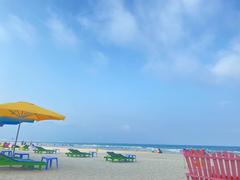Vietnam Naval Academy Visiting Hours, Tickets, and Travel Guide in Nha Trang
Date: 14/06/2025
Introduction
The Vietnam Naval Academy (VNNA), located in the vibrant coastal city of Nha Trang, is both a cornerstone of Vietnam’s naval education and a prominent symbol of the nation’s maritime heritage. Since its founding in 1955, the Academy has played a pivotal role in shaping Vietnam’s naval forces, advancing maritime research, and supporting regional security. While the Academy operates primarily as a military institution with restricted access, its imposing architecture, rich history, and proximity to Nha Trang’s cultural attractions make it an intriguing destination for history enthusiasts and curious travelers alike.
This comprehensive guide explores the Academy’s evolution, academic excellence, visitor information (including access policies, tour options, and travel tips), and nearby attractions, ensuring you are well-prepared for a meaningful visit to Nha Trang and its naval landmarks.
Table of Contents
- Introduction
- Historical Evolution and Significance
- Academic Structure and Programs
- International Collaboration and Regional Role
- Facilities and Modernization
- Visitor Information: Hours, Tickets, and Tours
- Getting There and Accessibility
- Nearby Attractions and Travel Tips
- Practical Visitor Tips and Etiquette
- Frequently Asked Questions (FAQ)
- Visuals and Media Suggestions
- Contact and Further Information
- Conclusion and Call to Action
- References
Historical Evolution and Significance
Founding and Early Development
Founded in 1955 as the Coastal Training School, the Vietnam Naval Academy was established to professionalize and expand Vietnam’s naval forces in the post-colonial era (Wikipedia). Over time, the Academy underwent several name changes, reflecting its evolving mission and broadening scope—eventually becoming the Naval Academy in 1993. The curriculum, initially influenced by French and later American and Soviet naval doctrines, adapted to meet the growing demands of the Vietnamese navy and the region’s shifting geopolitical landscape (USNI Proceedings).
Role in National Defense
The Academy’s graduates form the backbone of the Vietnam People’s Navy (VPN), Coast Guard, and Border Defence Force. With a training capacity that has historically reached 1,200–1,500 personnel at a time (RiverVet), the Academy is central to Vietnam’s maritime sovereignty, supporting defense efforts in the South China Sea and contributing to search and rescue, humanitarian missions, and marine environmental protection.
Academic Structure and Programs
Organizational Overview
Operated under the Ministry of National Defence, the Academy delivers a blend of academic, technical, and leadership education through specialized faculties, including:
- Naval Architecture and Marine Engineering
- Maritime Science
- Marine Power Engineering
- Automotive Engineering
- Military Science and Leadership
- Foreign Languages and International Relations
Supporting facilities feature ship simulators, research centers, and laboratories (NTU Faculty of Transportation Engineering).
Educational Offerings
- Undergraduate Programs: Focus on naval architecture, marine engineering, and maritime science, with practical training at naval bases.
- Postgraduate Programs: Masters and Ph.D. programs, including international joint degrees (e.g., with National Taiwan Ocean University).
- Short Courses: Ship automation, submarine design, and maritime safety—intended for active-duty officers and professionals.
Research and Innovation
The Academy leads research in ship automation, vessel design, new materials, and alternative fuels, often collaborating with international partners and industry.
International Collaboration and Regional Role
The Vietnam Naval Academy is a regional hub for naval education, fostering cooperation with the Royal Cambodian Navy and Lao People’s Navy (Wikipedia). Its international partnerships, including with universities in South Korea, Norway, and Taiwan, support student exchanges, research projects, and dual diplomas. Such collaborations underpin Vietnam’s role in regional maritime security and peacekeeping.
Facilities and Modernization
Located on a 30-acre beachfront campus in Nha Trang (USNI Proceedings), the Academy boasts:
- Modern classrooms, laboratories, and a 9,000-volume library
- Ship simulators and maritime training pools
- Sports and recreation facilities
- A campus dispensary and accessible infrastructure
- Recent upgrades in cyber defense, unmanned systems, and maritime surveillance (Wikipedia)
Visitor Information: Hours, Tickets, and Tours
Access Policy
Note: The Vietnam Naval Academy is an active military institution. General public access is restricted, and there are no regular open visiting hours or ticket sales. Visits are typically by prior arrangement for academic groups, official delegations, or during special public events (Trek Zone).
- Viewing the Academy: Visitors can admire the campus from public roads outside the grounds. The impressive exterior and ceremonial events, when visible, provide insight into Vietnam’s naval traditions.
- Guided Tours: Occasionally available by request or during designated events. Advance arrangements are essential.
- Photography: Permitted from outside; restricted within the campus. Always request permission before photographing personnel or sensitive areas.
Opening Hours (when tours are available)
- Weekdays: 8:00 AM – 4:30 PM (by prior arrangement)
- Weekends/Public Holidays: Closed
Entry Fees
- Admission: Free for authorized group visits or tours.
Getting There and Accessibility
Location
The Academy is centrally located in Nha Trang, along the beachfront, easily accessible from the city center and tourist sites (Trek Zone).
- Address: 02 Nguyen Dinh Chieu Street, Nha Trang, Khanh Hoa, Vietnam
Transportation
- By Air: Cam Ranh International Airport (30 km south); taxi or shuttle to city center (Olgapronkina)
- By Train: Nha Trang station on Vietnam’s north-south line (Vietnam Travel)
- By Bus: Intercity buses connect with other parts of Vietnam
- Local Transport: Taxis, Grab, and motorbike rentals are widely available (Shipped Away)
Campus Accessibility
- Mobility: The grounds are mostly flat but sandy, which may challenge those with mobility issues.
- Parking: Available for visitors with appointments.
- Restrooms: Facilities are present but basic.
Nearby Attractions and Travel Tips
Enhance your visit to the Academy by exploring Nha Trang’s historical and cultural landmarks:
- Po Nagar Cham Towers: Ancient Hindu temple complex
- Alexandre Yersin Museum: Celebrates a pioneering French bacteriologist
- Christ the King Cathedral: French colonial-era architecture
- Long Son Pagoda: Famous for its giant white Buddha statue
- National Oceanographic Museum: Marine research and biodiversity exhibits
- Nha Trang Beach: Ideal for relaxation and water sports
Travel Tip: The best time to visit Nha Trang is from January to August for sunny, dry weather. June offers fewer crowds and favorable conditions (Gonetovietnam; Frontier Travel Vietnam).
Practical Visitor Tips and Etiquette
- Identification: Bring valid ID for any arranged visits.
- Attire: Modest clothing is recommended to respect the Academy’s formal environment.
- Footwear: Wear sturdy shoes due to sandy grounds.
- Sun Protection: Use sunscreen, hats, and sunglasses.
- Language: Basic English is spoken; learning a few Vietnamese phrases is helpful.
- Conduct: Be respectful, avoid disruptive behavior, and follow all security instructions.
Frequently Asked Questions (FAQ)
Q: Can I visit the Vietnam Naval Academy without prior arrangement?
A: No. The Academy is a military institution with restricted access. Visits require prior permission or participation in organized group tours.
Q: Are there any entrance fees or tickets?
A: No. Authorized visits are free of charge.
Q: What are the visiting hours?
A: There are no regular public visiting hours. Arranged visits typically occur on weekdays during working hours.
Q: Is photography allowed?
A: Only from outside the campus, or with permission during guided tours.
Q: What other attractions are nearby?
A: Po Nagar Cham Towers, Long Son Pagoda, Alexandre Yersin Museum, and Nha Trang Beach.
Q: How do I get to the Academy from Cam Ranh Airport?
A: Taxis and shuttles are available for a 40–45 minute trip to the city center.
Visuals and Media Suggestions
Include images of:
- The Academy’s main building and beachside campus (“Vietnam Naval Academy campus beachfront view”)
- Ceremonial events or training vessels (“Vietnam Naval Academy training vessels”)
- Nearby attractions like Po Nagar Cham Towers and Nha Trang Beach
Use descriptive alt text for all images to enhance accessibility and SEO.
Contact and Further Information
- Address: 02 Nguyen Dinh Chieu Street, Nha Trang, Khanh Hoa, Vietnam
- Telephone: +84 (258) 2471387
- Email: [email protected]
- Website: NTU Faculty of Transportation Engineering
- Tourism Info: Khanh Hoa Department of Culture, Sports and Tourism
Conclusion and Call to Action
The Vietnam Naval Academy stands as a testament to Vietnam’s maritime legacy, educational excellence, and regional leadership. While public access is limited, its imposing presence enriches Nha Trang’s cultural landscape and serves as a gateway to learning about Vietnam’s naval history. Combine your visit with nearby historical sites for a full immersion in the city’s coastal heritage.
Plan your trip today: Download the Audiala app for the latest travel guides, event updates, and visitor resources. Follow us on social media for new articles, inspiration, and exclusive tips for exploring Vietnam’s maritime and military heritage.
References
- Vietnam Naval Academy in Nha Trang: History, Visitor Information, and Nearby Attractions
- Vietnam Naval Academy Visiting Guide: Hours, Tickets, Tips & Nearby Nha Trang Historical Sites
- NTU Faculty of Transportation Engineering
- USNI Proceedings
- RiverVet
- NZZ
- Olgapronkina
- Vietnam Travel
- Shipped Away
- Gonetovietnam
- Frontier Travel Vietnam
- Local Vietnam
- Khanh Hoa Tourism Portal

